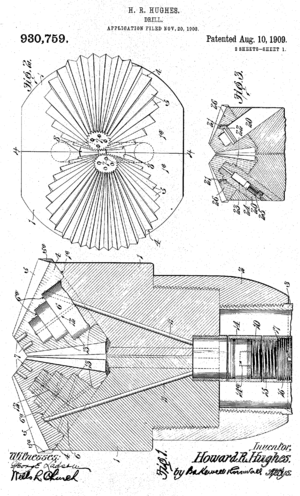Directional Drilling
This article was initially written by Robert Woods, ASME Fellow. This article contains material published in Mechanical Engineering Magazine Sept. 2013. Copyright 2013 American Society of Mechanical Engineers
Well drilling has reached a stage of development where it is possible to drill vertically into the Earth for a mile or more and then make an abrupt turn in any direction. Remarkable as this is, it gets less attention than processes like hydrofracking or the oil shale production which it enables.
The ability to control the trajectory of a well bore, known under the heading "directional drilling," is a marriage of technologies that matured during the twentieth century.
Steering a wellbore is only practical because drilling has become fast enough and economical enough to enable it. Drilling owes its current efficiency to an invention patented in 1909 by Howard Hughes, Sr.
A well drill bit once resembled a carpenter's drill. It was slow, needed frequent replacement, and required large forces provided by the weight of the drill string. The highest patent, which became the foundation of an industrial empire later expanded by Howard Jr., disclosed a drill bit with two rotating, toothed, cutting wheels. ASME has recently recognized it as a Historic Mechanical Engineering Landmark.
A second key technology, which matured in the 1970s, is the downhole drill motor. This innovation replaces rotation of the entire drill string with independent rotation of the drill head, using a downhole turbine-driven mechanism.
The system makes ingenious use of drilling fluid, known as "mud," which is used to lubricate the drill string and to provide hydrostatic pressure to prevent blowouts.
Drilling involves two or more concentric pipes. Mud is pumped through one or through the annular space between pipes and exhausted through another. The flow of fluid and the difference in pressure between inflow and exhaust is the source of downhole power. When passed through a hydraulic turbine, it can drive a drill head.
Downhole drilling systems work at temperatures as high as 300 F and pressures up to 10,000 psi. The same working fluid that powers mechanisms also carries two-way communication between the surface and the drillhead. This pulse data string can carry commands or diagnostic information. It allows operation in a closed loop.
Inertial navigation technology, developed for aircraft, is often used for position data.
Steering can be achieved in a number of ways. Small vanes may extend or retract at appropriate stages of the rotational cycle so as to bias drilling direction. An inline series of packages can move relative to each other to shape a curve in the well bore. The drill head itself can bore in a preferred direction, cutting more or less during different parts of the cycle. Curve radii on the order of 200 to 1,000 meters are common.
A development that appeared in the 1960s is "coiled tubing" - the drill string is a single tube delivered in a coil as much as 1,500 meters in length. This replaces a series of pipes connected by screw threads. The single tube has the advantage of a faster insert and withdrawal times and mechanical simplicity. Use of such tubing is only possible because the downhole drilling technology has made it unnecessary to rotate the entire drillstring.
The technology has revolutionized the well drilling industry.
